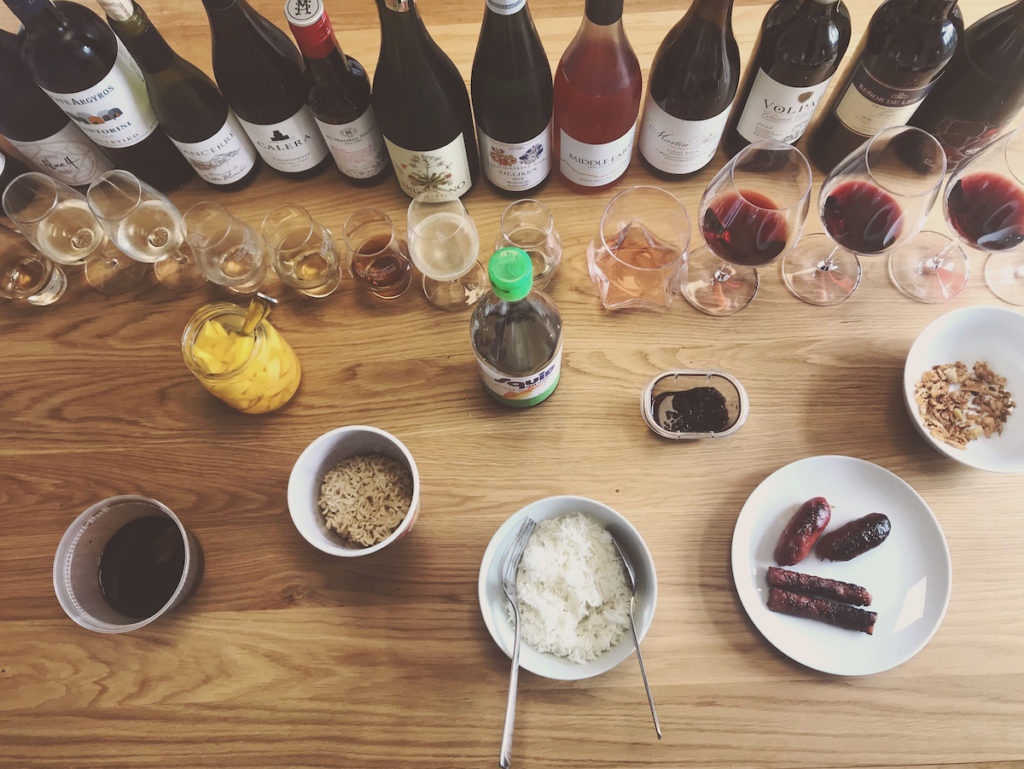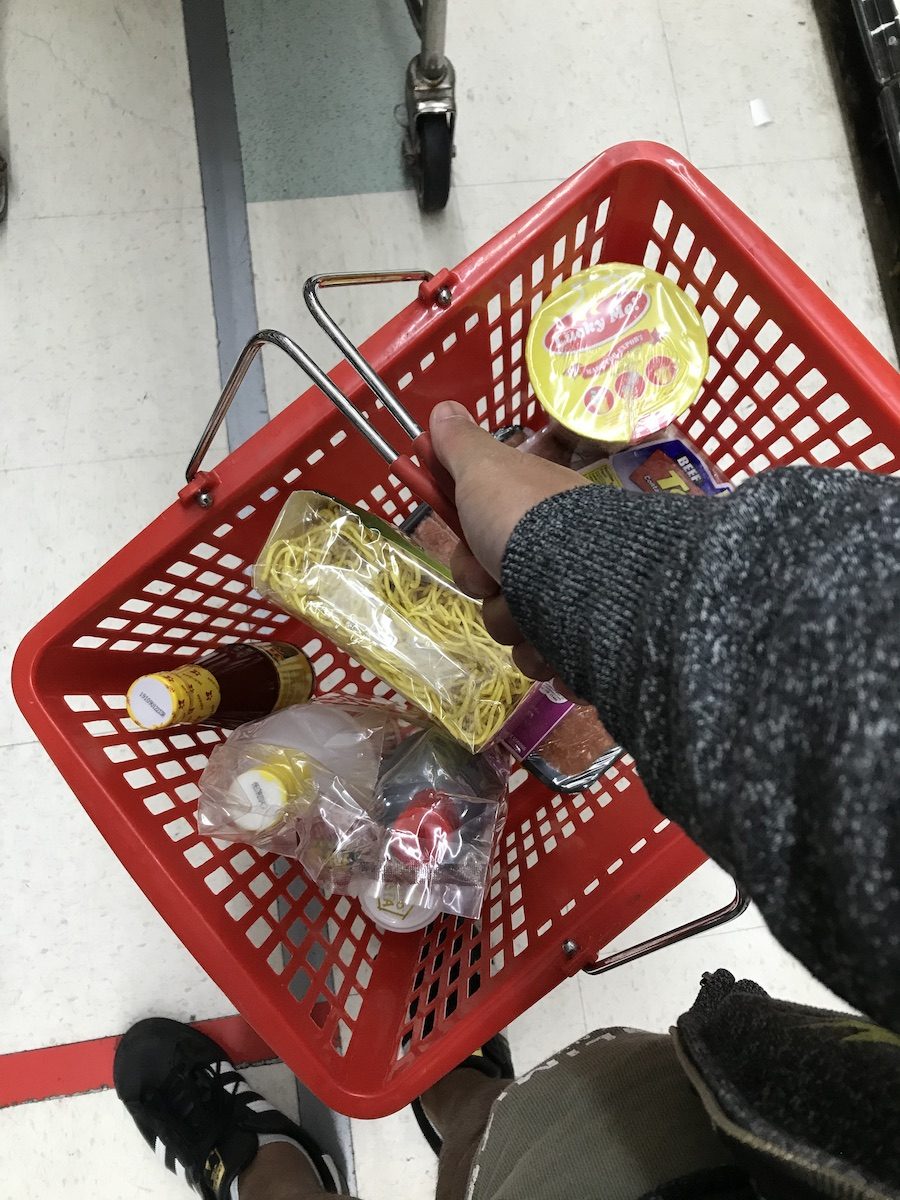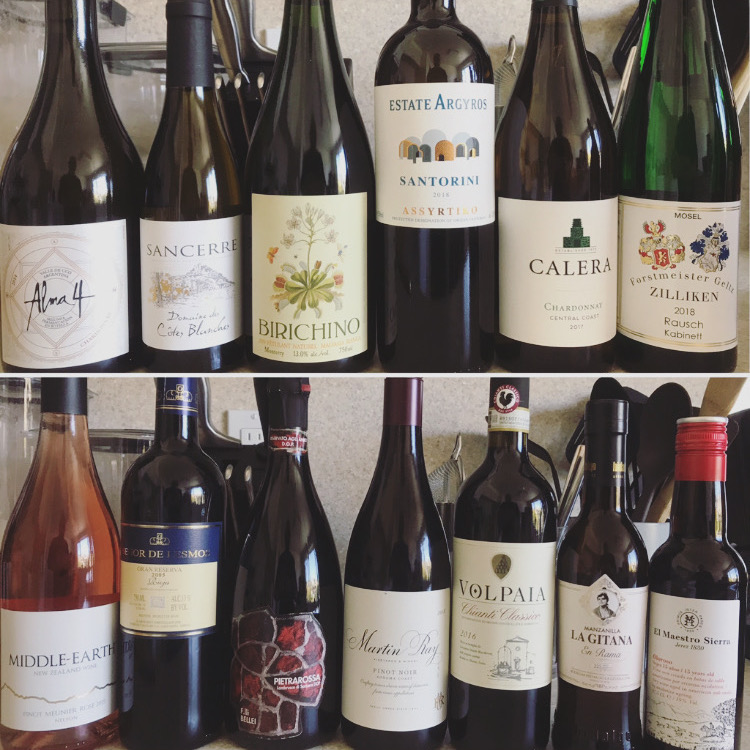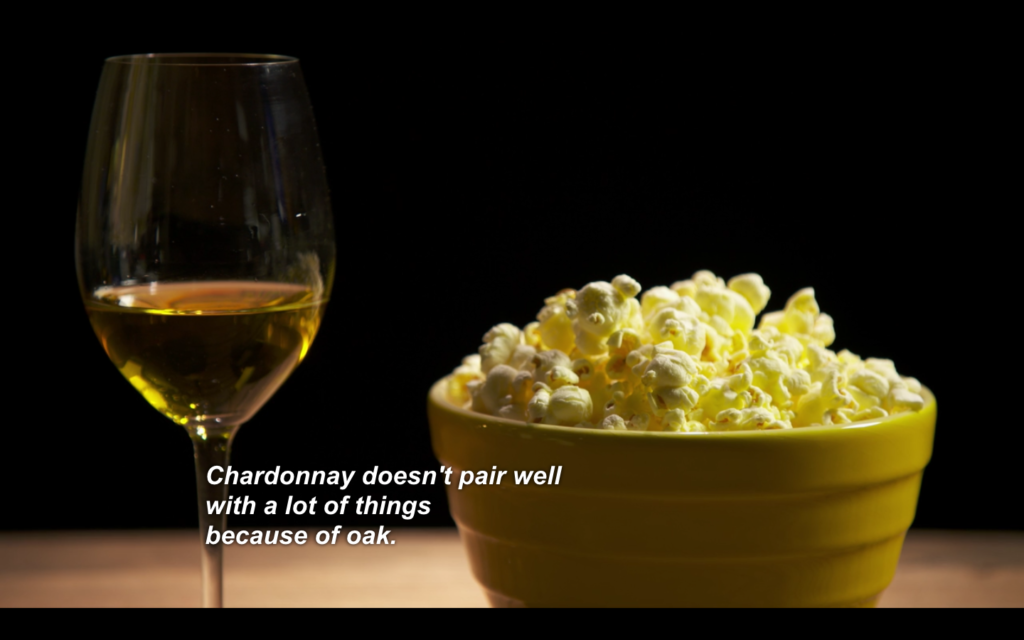I never thought it would feel this quick, but I’ve spent almost 10 years in the wine industry, accompanied by all types of grapey gripes. They range from folks who think red wines are served too warm (which is a perfectly reasonable thought that I also vibe with), to those who decry Chardonnay as if it was Satan manifested into a liquid. Some are oddly offended by the slightest hint of sugar to the point where anything remotely sweeter than battery acid is considered a flaw. I’m not here to yuck anyone’s yum (even when said yum yucks other yums), but damn. Let’s loosen our sommelier pins just a smidgen.
Onto what Lagrein-ds my gears: I fucking hate pairing suggestions that generalize off-dry wines into super generic categories for particular cuisines, like this line: “try this German Riesling with Asian food”. As I saw with my experiments, this combination structurally worked with a good chunk of the Filipino food pairings, but the flavours themselves were surprisingly mismatched more often than not. We normally love to check certain boxes from the “traditional rules” of wine pairing: for example, the body of the wine has to match the weight of the food, and the wine always has to be sweeter than what you’re eating it with. From my experiments comes a new set of rules busting out of the box like Shangela, especially for the piercing and bright flavours of the Philippines.

As a Filipino in the wine industry, I’ve never made any in-depth attempts to combine the two parts of myself until recently, besides a blog post on adobo wine pairings in 2012, which coincidentally has the most hits on my blog. More on that later.
Why isn’t Filipino food talked about in the context of wine? Are we not marketable enough to be that mainstream despite the fact that we’re deeply woven into the history of the USA? Do we not fit the West’s idea of food worthy enough for wine? Is Filipino cuisine just foreign enough for the wine industry to ignore?
(Besides lumpia. Why is lumpia the immediate topic of conversation for so many gay white men I’ve dated in the past?)
(…I don’t know why I ask the question when I know the answer.)
One night, two Filipinos seated themselves at this wine bar I worked at – we had a brief discussion on Filipino restaurants and why there weren’t that many, especially in the context of more “modernized” styles that touch other Asian cuisines. They came to this conclusion: if you want good Filipino food, go to a Filipino person’s house. Combine this with the fact that we’re arguably the most modern example of a far-reaching culture borne from fusion, and what results is this culinary culture that shares so many Venn diagrams with other cultures, but those intersections have flourished into their own marvels that we call our own. For example, the main flavour components of adobo, the de facto national dish of the Philippines, is soy sauce and cane vinegar. Soy sauce is hardly unique to the Philippines, but we’ve elevated this combination into its own moment.
I’ve been thinking about this experiment for a while: how can I distill the most unique and/or prevalent flavours of the Philippines and see how they interact with a broad spectrum of wines? My gears turned for a couple of weeks.
Now – I could go on and on about the political and historical effects of the Philippines’ fragmented geography and its 7000+ islands, so you can imagine how accurately I wanted to illustrate the unique and prevalent flavours of the archipelago without ignoring the different cultures within the country. So I’ve distilled it down to just a handful: the previously mentioned combination of soy sauce and cane vinegar, for example, is an obvious one to include. But even though I didn’t incorporate the coconut-accented flavours of Mindanoan cuisine in my experiments, it would be remiss of me not to acknowledge that these flavours, among many, are important to Filipino cuisine as a whole. So there’s still more work to be done!

With the flavours I chose and the wines I hypothesized might match, I came up with a matrix of 7 flavours and 13 wines for a total of 91 combinations which I decided to attack on a Friday afternoon. Delicious, but less fun than you think. Gulp.
I will discuss each of these flavours along with what worked (and what didn’t) in their own individual posts, but here are the 7 that I chose to represent a broad snapshot of Filipino cuisine:
- vinegar + soy sauce (e.g. in adobo, the de facto national dish of the Philippines)
- calamansi (a citrus important to the Philippines, used as a flavour or dressing in foods such as pancit; also a partial approximation to tart Filipino foods, like sinigang)
- burong mangga (pickled green mango, as a general approximation for the green fruits used in Filipino cuisine, such as papaya, jackfruit, and guava)
- longganisa (a sweet and spicy sausage with variations found in other countries around the world, but with a distinctly sweet and fruity flavour that sets it apart from other versions)
- bagoong (a fermented fish paste which adds a unique funk)
- fish sauce or patis (a salty condiment and byproduct of bagoong)
- browned garlic (e.g. in sinangag, also know as garlic fried rice)
Each flavour had its own pairing theory, and in total, I ended up with 13 styles:
- a biologically-aged sherry
- Hidalgo “La Gitana” Manzanilla en Rama (Jerez, Spain) 375ml. Jul 2020. $14 USD.
Salted almonds with hints of caramel, lemon zest, and something like asphalt – a pleasant dusting of something rubbery on the nose. Adolescent summer days? Dry, savoury, lithe, and nutty. A little less tense than I expected, but still quite impactful.
- a sparkling white (ideally, a style to bridge the austere Old World and the more upfront New World)
- Alma 4 2014 Chardonnay Sparkling Wine (Uco Valley, Mendoza, Argentina) July 2020. $22 USD.
After letting this open up, I get a beautiful nose of browned butter, bread crust, peach tea, and hints of baked apple. Lively mousse gives way to green apple and a really lively acidity on the palate. Slightly jagged on the palate, but for this, $22 is a steal. Damn, Argentina.
- an austere and mineral-driven white wine
- Argyros 2018 Estate Assyrtiko (Santorini, Greece) Jul 2020. $30 USD.
All that crushed chalk, mouthwatering green apple, and lime skin on the nose. Really intense acidity with some stuffing on the palate to match; some Assyrtiko I’ve had have been a bit too razor-sharp for my liking but this really hits the spot. Hints of mineral bitterness at the very end really anchors it down. Perhaps I would guess Chablis in a blind tasting, but that extra edge of electric intensity would have – and should – take me somewhere else.
- a zippy, aromatic, and citrus-driven white wine
- Domaine des Côtes Blanches 2019 Sancerre (Central Vineyards, Loire Valley, France) 375ml. Jul 2020. $10 USD.
Ripe apple and grapefruit on the nose, and that obvious full-frontal tropical fruit. Round for Sancerre, but still taut enough. Certainly a looser and riper style of Sancerre – perhaps the 14.1% ABV was a sign. Woof.
- a fuller and creamier white wine, potentially oaked
- Calera 2017 Central Coast Chardonnay (Central Coast, California) Jul 2020. $15 USD.
Hints of butter and green apple on the nose – almost a disjointed combo of smooth sailing and turbulent rocks. A bit of vanilla and some kind of sweet, earthy spice, like cinnamon. Round and ripe, but not without a hint of tautness that comes through after a second or two. Not super complex, but true and complete. Well-balanced at 14.5% ABV.
- an oxidatively-aged sherry
- El Maestro Sierra Oloroso (Jerez, Spain). 375mL. Jul 2020. $22 USD.
Oh yes – crushed almond, crushed pecan, something savoury – even as far as teriyaki sauce, and a squeeze of caramelized lemon. Dry but not without a ribbon of cheeky ripeness that ends intensely and savoury. Lovely, gal. It’s not a wonder why all the trendy white people push sherry – it can smell like granola.
- an unfiltered and funky white pét nat
- Birichino 2019 “Pétulant Naturel” Malvasia Bianca Pétillant Natural (Monterey, California) Jul 2020. $25 USD.
Hazy lemon. Straight up reminiscent of heady and lively examples of Moscato d’Asti and I am completely here for it – all blossoms and bits of orchard fruit, but with a yeasty undertone that transforms everything once you revisit the glass. A funkier and meatier palate, with kisses of liquorice and short-lived bubbles.
- an off-dry and taut German Riesling
- Zilliken 2018 Saarburger Rausch Kabinett Riesling Saar (Mosel, Germany) Jul 2020. $30 USD.
Really closed on the nose except for a bit of crushed rock and something sweet, brisk, and alpine – like a single ripe nectarine tumbling down a mountain. The palate holds none of this shyness and opens up with an off-dry parade of ripe nectarine, peach, green apple, and crushed rock. What a treat that this opens up to. Impeccably balanced.
- an off-dry rosé (ideally bridging stony and fruity styles)
- Middle-Earth 2019 Rosé (Nelson, New Zealand) Jul 2020. $15 USD.
100% Pinot Meunier – already into it. Beautiful pale pink with notes of pink grapefruit, green strawberry, and white flowers – though the fruit character gets riper with a little bit of warmth. Pleasantly off-dry, and just barely – the sweetness is wrapped up nicely by a wave of stoniness and petrichor on the palate. Though it’s been years since I’ve had it, this reminds me of the Sokol Blossor rosé from Oregon.
- a fruity red with soft tannins
- Martin Ray 2018 Sonoma Coast Pinot Noir (Sonoma Coast, Sonoma, California) Jul 2020. $17 USD.
Black cherries, earth, and hints of black pepper. Even a smidgen of bacon. Not necessarily as fruity as I was expecting at first sniff, but with air it’s revealing more of that ripe strawberry fruit. Crowd-pleasing! A bit more heavy-handed than I would have expected for Pinot (I would have loved either more ripeness to push it over the edge or more structure to cinch its waist – this is sort of in the middle) but it’s complete enough for me to enjoy. With time, more fruit hops out of the glass.
- a savoury Old World red from a recent vintage
- Castello di Volpaia 2016 Chianti Classico (Tuscany, Italy) Jul 2020. $20 USD.
Cover just-ripe cherries with chocolate and toss on a dried herb or some cured meat, and that’s what we have here. Has a sense of anise-like dustiness to the nose – a hint of something shy and nervous and locked away in a mysterious box in a spice shop. The palate is much more revealing, with broad and grippy tannins along with more of that dried and woody spice character. Quite mouth-drying, but on its way to becoming even better with age.
- a savoury Old World red from a relatively older vintage
- Bodegas Casa Juan Señor de Lesmos 2005 Rioja Gran Reserva (Rioja, Spain) Jul 2020. $30 USD.
Oh wow. It’s a symphony of ripe berries: there’s some earthy leafiness of a raspberry, the dark-tinged sweetness of a blackberry, a hint of the austerity and floral character of a blueberry, with everything wrapped in a strawberry bubble. Underneath everything there’s a layer of something savoury and green, like a herbed balsamic reduction. The characters flip on the palate: this savoury sauce becomes the conductor, and each berry plays a different fiddle. The piece ends with some chalky tannin and a kiss of cola and earth. Should be 85% Tempranillo and 15% Mazuelo.
- a Lambrusco (ideally, one that’s on the off-dry+ side)
- Bellei Lambrusco di Sorbara Pietra Rossa (Emilia-Romagna, Italy) Jul 2020. $15 USD.
A bubbly pale red. Not much on the nose except a bit of peach and cranberry skin – perhaps a hint of yeast. The palate is barely off-dry, with really lively and creamy mousse. There isn’t much intensity to the flavours on the palate at all, though – it’s a whisper of aroma on the nose that leads to booming textural energy. It’s not terrible – I just expected more fruit. I can also say the same about gay sports bars.

Again, each flavor is getting its individual post, but here’s the quick lowdown:
- Pairing with reds is tough since the vinegar and other bright notes of Filipino food can often flatten reds, unless you go to lengths to make sure the flavors don’t overwhelm.
- Acidic whites might seem like an obvious go-to with the salt, sour, and funky flavours of Filipino food, but the combination can often end up being too shrill for one mouthful.
- Full and sturdy whites, while not an obvious pick, have the potential to NOT compete with the intense flavours of Filipino food and give room for both the food and the drink to shine – this is contrary to Western “rules” of food and wine pairing.
- You’ve gotta be picky with wines strong in citrus fruit or floral notes – even if the structure is sound, these flavors may not necessarily add anything positive to the dishes (at least, with this first wave of flavours).
The Chardonnay in particular was one I didn’t think would sing quite well. I thought of this scene, from SOMM 2:

Hold my adobo.